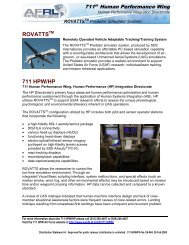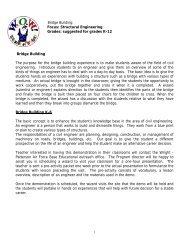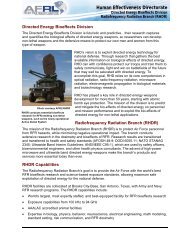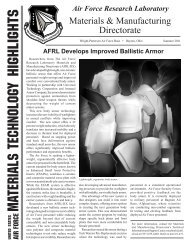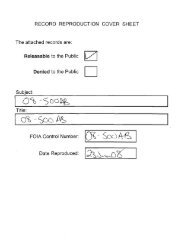TO 00-20-14 30 SEPTEMBER 2011 - Wright-Patterson Air Force Base
TO 00-20-14 30 SEPTEMBER 2011 - Wright-Patterson Air Force Base
TO 00-20-14 30 SEPTEMBER 2011 - Wright-Patterson Air Force Base
- No tags were found...
You also want an ePaper? Increase the reach of your titles
YUMPU automatically turns print PDFs into web optimized ePapers that Google loves.
<strong>TO</strong> <strong>00</strong>-<strong>20</strong>-<strong>14</strong> <strong>30</strong> September <strong>20</strong>11a. World Geodetic System of 1984 (only if Loran C is still in use): Geodetic positions, Latitudes andLongitude in degrees, minutes, and seconds. Required in order to perform accurate time measurements.Loran C requires a minimum 10 arc seconds accuracy for latitude and longitude.b. International Gravity Standardization Net of 1971 (IGSN 71): Gravity information in milligals. The requiredaccuracy for use with dead weight piston pressure standards is 5 mGals. As long as the PMEL does not move,there is no need for an update. If your PMEL has moved to a new location, then your force and pressurestandards shall be recalibrated using the new gravity value before they can be used to obtain maximum accuracy.c. Astronomic Data. Astronomic azimuth in degrees, minutes and seconds. Needed if the PMEL is supportingnorth-seeking gyrocompass units. Accuracy needed is 10 arc seconds or less.8.2 PMEL ENVIRONMENT.<strong>TO</strong> 33K-1-1<strong>00</strong>-2 identifies the measurement restrictions of measurement standards. To ensure measurement accuracy, itis necessary to maintain continuous control of the environment in which the measurement standards are maintained.Temperature, humidity, dust, vibration and electromagnetic interference can each have a detrimental effect on the abilityof a standard to ensure measurement accuracy of TMDE. Each of the environmental factors impact calibration and repairoperations to a different degree. It is a fact that most standards change value with a change in temperature. Thetemperature limits placed on the PMEL ensure that the measurement confidence level meets the needs of some of themore precise equipment. Humidity control is becoming a very significant environmental need in the PMELs, especiallyat the lower humidity levels because of the potential for electrostatic discharge (ESD) damage to integrated microcircuitry, as well as its interference with sensitive measurements. Therefore, a PMEL whose environment goes outsidethe limits for temperature and humidity cannot ensure calibration accuracy and/or presents an operating hazard to someelement of the measurement setup. The calibration procedures may provide other restrictions.8.2.1 PMEL Environmental Control System (ECS) Effectiveness. The ECS shall maintain the laboratory environmentso that each room used for calibration meets requirements at least 90% of the time. When the PMEL ECS cannotmaintain environmental specifications 90% of the time or more, aggressive action on the part of PMEL/upper-levelmanagement is required. Excessive out-of-tolerance periods can contribute to equipment degradation, production slowdownsor stoppages. PMELs may seek assistance from the Civil Engineering Maintenance Inspection Repair Team(CEMIRT) through their local Civil Engineering for assistance with long-term out-of-tolerance conditions.8.2.2 ECS Outages. Laboratory management shall ensure nothing listed as environmentally sensitive is to be calibratedduring environmental outages, unless special provisions are made, documented, and the documentation kept on file. AnEnvironmental Outage Log* shall summarize environmental data for each environmental monitor to include:a. Total hours recorded.b. Total hours temperature above applied limits.c. Total hours temperature below applied limits.d. Total hours relative humidity above applied limits.e. Total hours relative humidity below applied limits.f. Total hours overlap (both temperature and relative humidity outside limits).g. Total hours of missing data (e.g., dry pens, clock stopped, chart overrun).*Not required if recorded in PAMS Environmental Log or IAW <strong>TO</strong> 33K5-4-9<strong>00</strong>2-10.8-2




